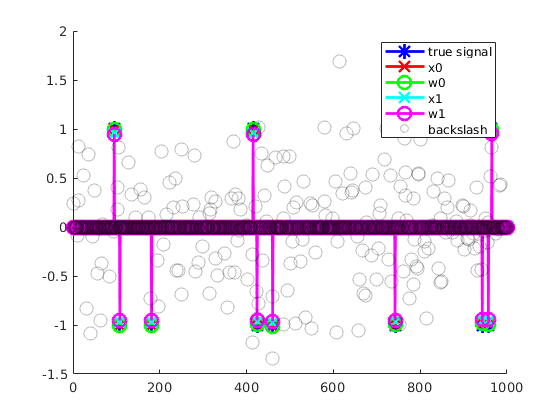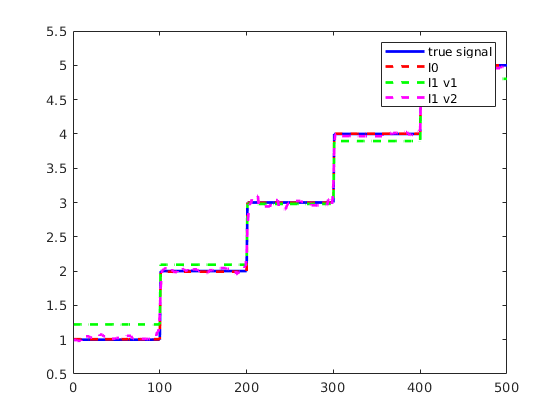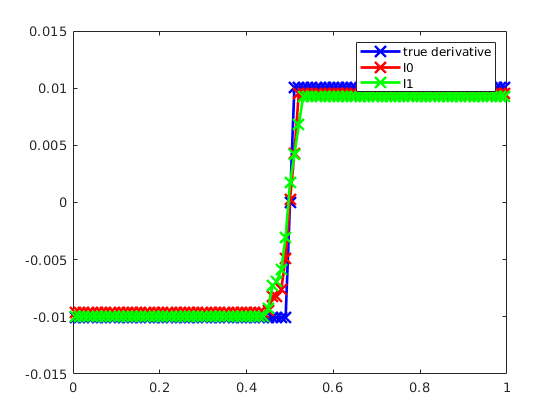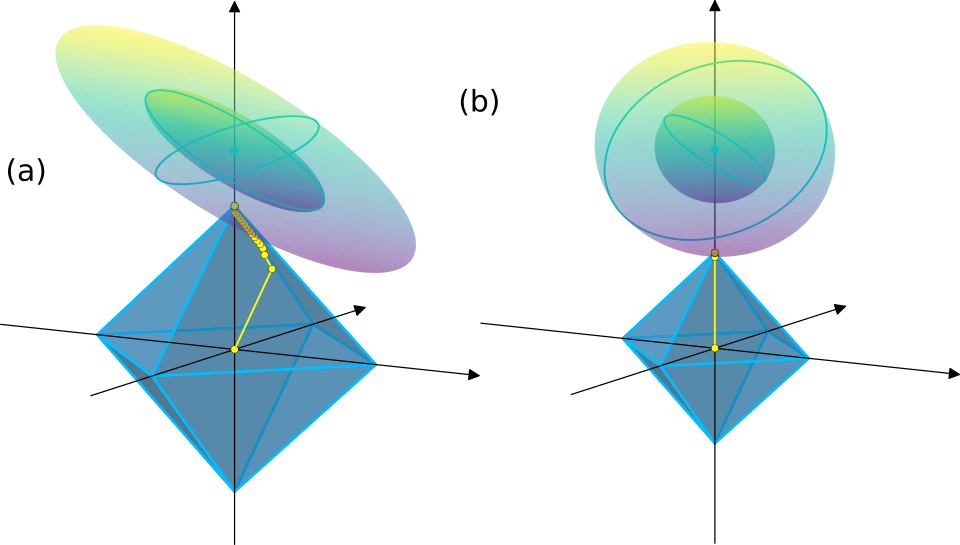Problem 1: \(\ell_1\) vs \(\ell_0\) penalties
In this problem we test the performance of using SR3 to recover a sparse signal. Here \(R\) is either the \(\ell_1\) or \(\ell_0\) penalty. We also plot the results of a least squares fit and the built in lasso function (if available). This is a relatively easy problem and all of the regularizers perform well, beating the standard least squares approach for obvious reasons.
% matrix dimensions m = 200; n = 1000; k = 10; % number of non-zeros in true solution sigma = 1e-1; % additive noise A = randn(m,n); y = zeros(n,1); ind = randperm(n,k); y(ind) = sign(randn(k,1)); b = A*y+sigma*randn(m,1); % set up parameters of fit lam1 = 0.01; % good for l_1 regularizer lam0 = 0.004; % good for l_0 regularizer % apply solver [x0, w0] = sr3(A, b, 'mode', '0', 'lam',lam0,'ptf',0); [x1, w1] = sr3(A, b, 'lam',lam1,'ptf',0); % built-ins xl2 = A\b; if exist('lasso','builtin') xl1 = lasso(A,b,'Lambda',lam1); end % plot solution % both regularizers perform well on this problem, though the $\ell_1$ % regularizer introduces a little more bias figure(); hold on; plot(y, '-*b'); plot(x0, '-xr'); plot(w0, '-og'); plot(x1, '-xc'); plot(w1, '-om'); scatter(1:length(xl2),xl2,'ok', ... 'MarkerFaceAlpha',0.25,'MarkerEdgeAlpha',0.25); if exist('lasso','builtin') plot(xl1,'-ok'); legend('true signal', 'x0', 'w0', 'x1', 'w1','backslash','lasso'); else legend('true signal', 'x0', 'w0', 'x1', 'w1','backslash'); end clear;

Problem 2: regularized derivatives
In this problem, we take random projections of a smooth signal and attempt a reconstruction under a piecewise smoothness promoting regularization. Specifically, we assume \(x\) to be a piecewise smooth 1D signal (though the measurements are possibly corrupted by noise). We consider both \(x\) given by a hat function and \(x\) given by a piecewise constant function. We then let \(A\) be an \(m \times n\) random measurement matrix, with \(m < n\). We set up \(C\) to be the \(n-1\times n\) matrix mapping the signal to a finite difference approximation of the derivative. We then reconstruct the signal as the cumulative sum of \(w\), adjusting for the integration constant.
iseed = 8675309; rng(iseed); n = 500; m = 100; sigma = 0.1; A = randn(m,n); % set up signal as step function (sparse derivative assumption) y = zeros(n,1); for i = 1:5 y((i-1)*100+1:i*100) = i; end b = A*y + sigma*randn(m,1); e = ones(n,1); C = spdiags([-e,e],[0,1],n-1,n); % difference matrix lam0 = 0.01; lam1 = 0.02; lam1_2 = 0.002; % apply solver [x0, w0] = sr3(A, b, 'mode', '0', 'lam',lam0,'ptf',0,'C',C); [x1, w1] = sr3(A, b, 'mode', '1', 'lam',lam1,'ptf',0,'C',C); [x1_2, w1_2] = sr3(A, b, 'mode', '1', 'lam',lam1_2,'ptf',0,'C',C); cs = cumsum([0;w0]); y0 = cs + (sum(x0)-sum(cs))/n; cs = cumsum([0;w1]); y1 = cs + (sum(x1)-sum(cs))/n; cs = cumsum([0;w1_2]); y1_2 = cs + (sum(x1_2)-sum(cs))/n; figure() plot(y,'b') hold on plot(y0,'--r') plot(y1,'--g') plot(y1_2,'--m') legend('true signal', 'l0', 'l1 v1', 'l1 v2'); % set up signal as piecewise linear (Chartrand example) % note that here the regularization is on the second derivative % also, the regularization is sensitive to lambda n = 100; t = linspace(0,1,n).'; tmid = (t(2:end)+t(1:end-1))/2.0; h = t(2)-t(1); y = abs(t-0.5); b = y + sigma*randn(n,1); bstart = b(1); b = b-bstart; sigma = 0.05; A = tril(ones(n,n-1),-1)*h; e = ones(n,1); C = spdiags([-e,e],[0,1],n-2,n-1)/h; lam0 = 0.007; lam1 = 0.001; xi = diff(b)/h; wi = C*xi; kappa0 = 1.0*h; kappa1 = 1.0*h; % apply solver [x0, w0] = sr3(A, b, 'mode', '0', 'lam',lam0,'itm',10000,'ptf',0,... 'C',C,'x0',xi,'w0',wi,'kap',kappa0); [x1, w1] = sr3(A, b, 'mode', '1', 'lam',lam1,'itm',10000,'ptf',0,... 'C',C,'x0',xi,'w0',wi,'kap',kappa1); % reconstruct from w cs = cumsum([0;w0])*h; sw0 = cs + (sum(x0)-sum(cs))/length(cs); sw0int = A*sw0; coeffs = [sw0int,ones(n,1)]\(b+bstart); y0 = coeffs(1)*sw0int + coeffs(2)*ones(n,1); cs = cumsum([0;w1])*h; sw1 = cs + (sum(x1)-sum(cs))/length(cs); sw1int = A*sw1; coeffs = [sw1int,ones(n,1)]\(b+bstart); y1 = coeffs(1)*sw1int + coeffs(2)*ones(n,1); figure() plot(t,y,'b') hold on plot(t,b+bstart,'--','color',[0,0,0]+0.75); plot(t,y0,'--r') plot(t,y1,'--g') legend('true signal','corrupted', 'l0', 'l1'); figure() plot(tmid,diff(y),'-xb') hold on plot(tmid,diff(y0),'-xr') plot(tmid,diff(y1),'-xg') legend('true derivative', 'l0', 'l1');



